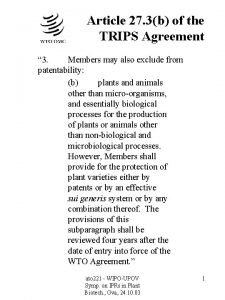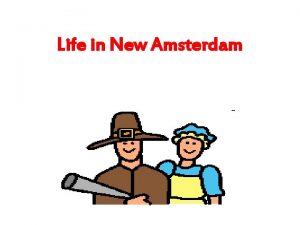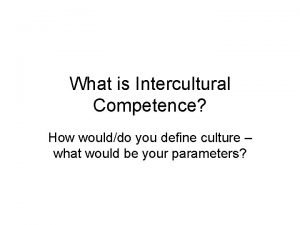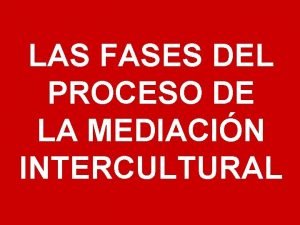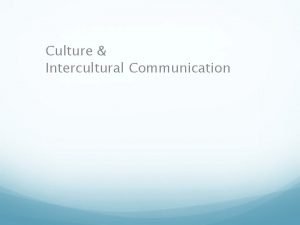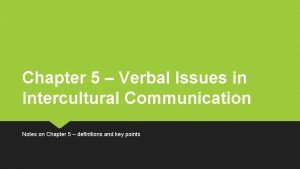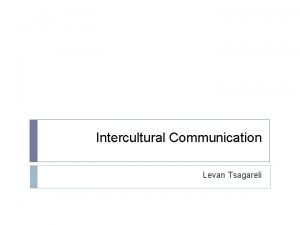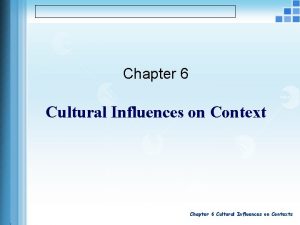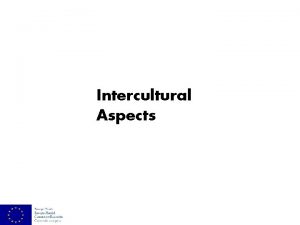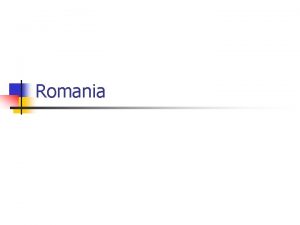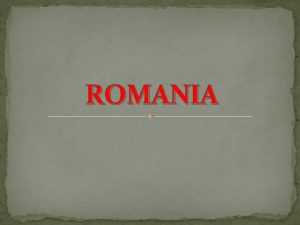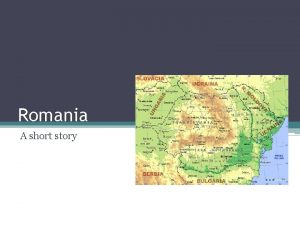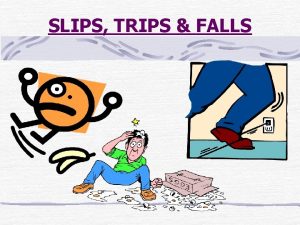Cultural influences in Romania Romania Intercultural trips in


























- Slides: 26

Cultural influences in Romania

Romania - Intercultural trips in Europe “Work like a slave, live like a king and create like a God” – We want to welcome you with the life motto of one of the greatest artists in the world, Constantin Brâncuşi, because we believe it represents best the Romanian people.

The European word can be distinguished by its cultural uniqueness given by cultural interferences that were remarked from the most ancient times. If we look at the Romanian space and its connections with the European world, the beginnings could take us back to pre-historic times. But we believe that the easiest to prove because there is material evidence would be the ones from the metal age when on our territory there were found: amber jewellery coming from the Polish space, swords coming from the Greek world, Greek coins, ceramic objects and other evidence that proves the contact of the Dacian world (Dacia is the ancient name of the Romanian space) with the Mediterranean world.

Greek swords

Greek coins

The 6 th-7 th centuries before Christ represented direct contact with the Greek world because the Greek colonists came and settled five localities on the shore of the Black Sea. The Dacians, our forefathers, settled a very powerful state in the 1 st century B. C. and starting from this moment, the links with the European world amplified. At first, we established good relations as neighbours with the Roman Empire, which was expanding, and starting with the beginning of the 2 nd century A. D. , after a series of four wars, Dacia becomes part of the Roman Empire. The most important consequence of this is, of course, the Romanization of the Dacian world and the development of economic and cultural connections with peoples who formed the Roman Empire. Maybe the common history of creating a future European nation should start here.

Scenes from Trajan’s Column

Images from the Dacian wars

Connections between peoples within the Roman world and from exterior become a reality of the beginning of the first millennium and they give the start of union in the European world. Middle Ages amplify connections with European peoples as well as with other nations from the Orient and the influences of the Oriental world become more powerful this time. Starting from the middle of the 14 th century the Turkish Empire begins to conquer space in East and Central Europe and the Romanian people keep direct contact with the Turkish world for 500 years. The influences are powerful, they start with the political organization and they continue with architecture and organization of house life, traces that can be identified in Romanian culture even today.

The great mosque from Constanţa

Narghile from Turkey

Later on, especially after the great geographical discoveries, after improving travelling on land on water, Europe doesn’t appear to be that big, connections between peoples become permanent and more powerful. There are relevant for the 16 th century and the next one the connections with Poland, France, Spain and Italy. A particular and special connection that lasted for a long period of time was established with the German world. Starting from the 12 th century there took place a process of colonization, especially of the Germans from the Rhine and from Saxony and the Danube was the link between the two nations. The Saxons formed here powerful localities; they settled rural and urban places. They played a remarkable part in developing agriculture, crafts and commerce and they influenced the communities’ life style starting with the organization of house life and continuing with the organization of the educational and law systems. There are numerous rural and urban settlements that keep German architecture, habits and life style of these inhabitants.

German settlements in Transylvania

Viscri church from Brasov built in German architectural style

In the Modern Age it was the forming of the nations and the effort of claiming their independence what strengthened the connection with European peoples that were under foreign occupation, like the Italians, the Greek and the Polish. Powerful cultural elite was gradually created and this elite interacted and was attached to the great innovative ideas of the 19 th century. A great number of the Romanian intellectuals were formed in famous universities like the ones in Krakow, Rome, Heidelberg, Sorbonne and others. They bring into the Romanian world ideas and actions based on equality, fraternity and democracy, ideas and actions that bring to Europe a great wave of change in this century. On the basis of these experiments Romanian culture and civilization is developing, education is also developing. Romanian education was considered among the most developed in Europe in the second half of the 19 th century; primary education had been compulsory from boys and girls since 1864.

First Romanian school from Brasov

The University in Bucharest – 19 th century

In the 19 th and 20 th century, Romania is known as a great producer of cereal, petrol and oil products, wood products, so that it is situated on the second place in Europe in the period between the two world wars. Commercial changes amplify in this period and human relationships as well. A decisive moment is setting free the commerce on the river Danube. The Romanians had important contributions in developing Maths, Medicine, Physics, Biology, Geography, Arts and Aeronautics. Among the greatest personalities, we can mention Constantin Brâncuşi, the great sculptor, Henri Coandă, the inventor of aerodynamics and of flying machines of great speed, doctor Paulescu, the one who invented the insulin, great writers such as Panait Istrati, Mircea Eliade, philosophers such as Emil Cioran and Constantin Noica, whose work and life is not only connected to Romania and the Romanians, but to Europe and the whole world.

Constantin Brâncuşi, the Romanian sculptor

Henri Coandă, the Romanian inventor

It would be unfair not mentioning our connections that were created via performance sports. You have definitely heard about Nadia Comăneci, who became a legend of the feminine gymnastics. Some of you may have heard about Gică Hagi, others about Ilie Năstase or about Ion Ţiriac and some of you probably about the boxer of great performance Bute, who keeps amazing the world with his results. You can also find in Romania the team of gymnastics trainers considered the most professional in the world: Belu and Bitang. Octavian Belu, for instance, managed to have his name in the world’s hierarchy because the teams that were trained by him received the biggest number of medals from all times.

The Romanian gymnast Nadia Comăneci

The Romanian footballer Gheorghe Hagi

As you may have noticed, we didn’t make any references to the numerous conflict situations that existed between our nations, no matter if they were allies or enemies, because we consider that wars are accidents in the course of history and not constructive periods. After all, the current European construction has, among other things, the great quality of eliminating conflict from the relationships between countries. This period distinguishes itself by means of constructive vocation, collaboration, preserving at the same time the specific features of each nation which is part of this project or is about to become part of it. We believe it would be fair to state that Romanian culture and civilization stands at the contact point between two great civilizations, the oriental and occidental one and between two great religions, Christian and Moslem. It is considered that we, the Romanians, have a culture of synthesis, which confers originality, freshness and everlasting value to it. You are going to find elements of these interferences in school and outside it and maybe you will be glad that we value them all by paying attention to them and by offering them conditions of development.


Thank you!
 Example of cultural influences
Example of cultural influences What cultural influences shaped the byzantines?
What cultural influences shaped the byzantines? Psychological influences on food choices
Psychological influences on food choices Jose trips over his untied shoelace
Jose trips over his untied shoelace Trips everywhere 4
Trips everywhere 4 Trips article 27
Trips article 27 Hse slips trips and falls video
Hse slips trips and falls video New amsterdam
New amsterdam Intrazonal and interzonal
Intrazonal and interzonal Rolling t formation
Rolling t formation Business trips for students
Business trips for students External-external trips
External-external trips Dale’s cone of experience
Dale’s cone of experience Adventure-trips in portsmouth
Adventure-trips in portsmouth Slips trips and falls presentation
Slips trips and falls presentation What is trips
What is trips Packaging reims
Packaging reims Dealskins
Dealskins Normandy school trips
Normandy school trips Trips everywhere
Trips everywhere Intercultural communication model
Intercultural communication model Define intercultural competence
Define intercultural competence Nonverbal intercultural communication
Nonverbal intercultural communication Etapas del proceso intercultural
Etapas del proceso intercultural Youtube intercultural communication
Youtube intercultural communication Intercultural communication notes
Intercultural communication notes Intercultural development continuum
Intercultural development continuum





